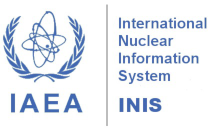Análise computacional da deposição de parafina em oleodutos de águas profundas utilizando técnicas nucleares
DOI:
https://doi.org/10.15392/2319-0612.2024.2760Palavras-chave:
wax deposition, nuclear technique, gamma radiation, Monte Carlo methodResumo
A deposição de parafina em dutos de petróleo é um problema que afeta a garantia de escoamento porque restringe a produção e em caso mais extremos, causa obstrução dos oleodutos. Esse problema ocorre com maior frequência em ambientes offshore, onde se encontram a maior parte dos reservatórios brasileiros em que a temperatura do oceano, em elevadas profundidades, é cerca de 5°C. Detectar a camada de parafina nas paredes internas dos oleodutos em seu estágio inicial evita paradas não programadas e grandes perdas econômicas. Dentre os vários métodos e técnicas encontrados na literatura para o monitoramento da deposição de parafina, as técnicas nucleares se diferenciam pelo fato de seu uso não interferir na integridade física do duto, pelo modo de operação não intrusivo e indireto (sem contato) e, portanto, não afeta o processo de transporte do petróleo. Este trabalho apresenta um modelo computacional utilizando o código Monte Carlo N-Particle 6 (MCNP6) e a técnica da perfilagem por transmissão da radiação gama para detectar a presença de parafina nas paredes internas de oleodutos utilizados no transporte de petróleo em águas profundas. Os resultados deste estudo mostram que o modelo é capaz de detectar a presença de até 5% de parafina (em relação ao raio interno do oleoduto) com uma exatidão de 7,4% em oleodutos utilizados em águas profundas.
Downloads
Referências
[1] MATOS, S. F.; ALTOÉ, L. Analysis of deepwater oil flow assurance in relation to wax deposition. Latin American Journal of Energy Research, vol. 6, no 2, p. 12–31, 2020, doi: 10.21712/lajer.2019.v6.n2.p12-31. DOI: https://doi.org/10.21712/lajer.2019.v6.n2.p12-31
[2] PORTO, T. R. N.; LIMA, A. G. B. De. Transient flow of waxy oil in a circular section pipeline: modeling and simulation, Holos, vol. 1, p. 155–173, 2017, doi: 10.15628/holos.2017.5220. DOI: https://doi.org/10.15628/holos.2017.5220
[3] AL-YAARI, M. wax deposition: mitigation and removal techniques. Society of Petroleum Engineers, p. 14–16, 2011. DOI: https://doi.org/10.2118/155412-MS
[4] THEYAB, M. A. Wax deposition process: mechanisms, affecting factors and mitigation methods. Open Access Journal of Science, vol. 2, no 2, mar. 2018, doi: 10.15406/oajs.2018.02.00054. DOI: https://doi.org/10.15406/oajs.2018.02.00054
[5] MATZAIN, A.; APTE, M. S.; ZHANG, H. Q.; VOLK, M.; BRILL, J. P.; CREEK, J. L. Investigation of paraffin deposition during multiphase flow in pipelines and wellbores - Part 1: Experiments. Journal of Energy Resources Technology, Transactions of the ASME, vol. 124, no 3, p. 180–186, set. 2002, doi: 10.1115/1.1484392. DOI: https://doi.org/10.1115/1.1484392
[6] BORDALO, S. N.; OLIVEIRA, R. Biphasic oil-water flow with wax precipitation in subsea oil production pipelines, 4° Congresso Brasileiro de Petróleo e Gás - PDPETRO, Campinas, São Paulo: Associação Brasileira de Pesquisa e Desenvolvimento em Petróleo e Gás - ABPG , out. 2007, p. 12.
[7] CHEN, X. T.; BUTLER, M.; VOLK, M. Techniques for measuring wax thickness during single and multiphase flow, SPE Annual Technical Conference and Exhibition, San Antonio, Texas: Society of Petroleum Engineers, out. 1997, p. 1–8. DOI: https://doi.org/10.2118/38773-MS
[8] VIANA, C. PIG Passage - Critical Operation: Concepts, Operations and Recommendations, LinkedIn. Accessed: May 30, 2023. [Online]. Available at: https://www.linkedin.com/pulse/passagem-de-pig-operação-crítica-conceitos-operações-viana/?originalSubdomain=pt
[9] MORAIS, J. M. Deepwater Oil: A Technological History of PETROBRAS in Offshore Exploration and Production. Brasília: PETROBRAS, 2013.
[10] MAJID, S. A.; MELAIBARI, A; MALKI, B. Hydrocarbon scale deposits measurements by neutron moderation and capture gamma methods, Nuclear Instruments and Methods in Physics Research B, vol. 119, p. 433–437, 1996. DOI: https://doi.org/10.1016/0168-583X(96)00296-0
[11] HOFFMANN, R.; AMUNDSEN, L.; SCHÜLLER, R. Online monitoring of wax deposition in sub-sea pipelines, Meas Sci Technol, vol. 22, no 7, 2011, doi: 10.1088/0957-0233/22/7/075701. DOI: https://doi.org/10.1088/0957-0233/22/7/075701
[12] CHEN et al., H. Ultrasonic detection and analysis of wax appearance temperature of kingfisher live oil, Energy and Fuels, vol. 28, no 4, p. 2422–2428, abr. 2014, doi: 10.1021/ef500036u. DOI: https://doi.org/10.1021/ef500036u
[13] MEI, I. L. S.; ISMAIL, I.; SHAFQUET, A.; ABDULLAH, B. Real-time monitoring and measurement of wax deposition in pipelines via non-invasive electrical capacitance tomography, Meas Sci Technol, vol. 27, no 2, dez. 2015, doi: 10.1088/0957-0233/27/2/025403. DOI: https://doi.org/10.1088/0957-0233/27/2/025403
[14] SOARES, L. L. O. Determination of the onset of paraffin deposition in oil production and transportation pipelines using a Multipoint Temperature Sensor. Federal University of Bahia, Polytechnic School, Salvador, 2017.
[15] OLIVEIRA, A. A. Historical success stories in the use of MAD-pig to locate obstructions in pipelines, Technical Bulletin of Oil Production, vol. 1, no 1, Rio de Janeiro, p. 95–126, 2006.
[16] KOPTEVA, A.; KOPTEV, V.; MALAREV, V.; USHKOVA, T. Development of a system for automated control of oil transportation in the Arctic region to prevent the formation of wax deposits in pipelines, Proceedings of EECE 2019: Energy, Environmental and Construction Engineering, St. Petersburg, Russia: EDP Sciences, nov. 2019. doi: 10.1051/e3sconf/201914007004. DOI: https://doi.org/10.1051/e3sconf/201914007004
[17] LOPES, R. T.; VALENTE, C. M.; DE JESUS, E. F. O.; CAMERINI, C. S. Detection of paraffin deposition inside a draining tubulation by the Compton Scattering Technique, Applied Radiation and Isotopes, vol. 48, no 10–12, p. 1443–1450, 1997, doi: 10.1016/S0969-8043(97)00255-8. DOI: https://doi.org/10.1016/S0969-8043(97)00255-8
[18] KOPTEVA, A.; STARSHAYA, V. Radioisotope measuring system for oil stream asphaltene-resin-paraffin deposits ARPD parameters. SPE Russian Petroleum Technology Conference and Exhibition, Moscow, Russia: Society of Petroleum Engineers, out. 2016, p. 1–7. DOI: https://doi.org/10.2118/182104-RU
[19] ABDUL-MAJID, S. Determination of wax deposition and corrosion in pipelines by neutron back diffusion collimation and neutron capture gamma rays, Applied Radiation and Isotopes, vol. 74, p. 102–108, abr. 2013, doi: 10.1016/j.apradiso.2013.01.012. DOI: https://doi.org/10.1016/j.apradiso.2013.01.012
[20] TAUHATA, L.; SALATI, I.; PRINZIO, R. D.; PRINZIO, A. R. D. Radioprotection and Dosimetry: Fundamentals, 10o ed. Rio de Janeiro: Comissão Nacional de Energia Nuclear, 2014.
[21] JOHANSEN, G. A.; JACKSON, P. Radioisotope Gauges for Industrial Process Measurements. Southern Gate, Chichester: John Wiley & Sons, 2004. DOI: https://doi.org/10.1002/0470021098
[22] KNOLL, G. F. Radiation Detection and Measurement, 4o ed. Ann Arbor, Michigan: John Wiley & Sons, 2010.
[23] LEITE, N. M.; LIRA, C. A. B. O.; RODRIGUEZ, A. G. Computational analysis for wax detection in deepwater pipelines using nuclear techniques. Brazilian Journal of Radiation Sciences, vol. 11, no 1A (Suppl.), p. 1–20, jul. 2023, doi: 10.15392/2319-0612.2023.2193. DOI: https://doi.org/10.15392/2319-0612.2023.2193
[24] BESERRA, M. T. F. Assessment of scale thickness in oil extraction pipelines. Institute of Radiation Protection and Dosimetry, Rio de Janeiro, 2012.
[25] SOARES, M. Fouling Detection System in Oil Pipelines Using Gamma Transmission Technique. Federal University of Rio de Janeiro, Rio de Janeiro, 2014.
[26] YORIYAZ, H. Monte Carlo Method: principles and applications in Medical Physics. Brazilian Journal of Medical Physics, vol. 3, no 1, p. 141–149, 2009.
[27] GOORLEY, J. T.; JAMES, M. R.; BOOTH, T. E.; BROWN, F. B.; BULL, J. S.; COX, L. J.; DURKEE, J. W. J.; ELSON, J. S.; FENSIN, MICHAEL LORNE FORSTER, ROBERT A. III HENDRICKS, J. S.; HUGHES, H. G. I.; JOHNS, R. C.; KI, A. J. Initial MCNP6 release overview -MCNP6 version 1.0. Los Alamos: Los Alamos National Laboratory, 2013. DOI: https://doi.org/10.2172/1086758
[28] LOS ALAMOS NATIONAL LABORATORY. Monte Carlo N–Particle Transport Code System Including MCNP6.1, MCNP5-1.60, MCNPX-2.7.0 and Data Libraries. Los Alamos, New Mexico: Radiation Safety Information Computational Center, 2013.
[29] JOHANSEN, G. A.; JACKSON, P. Salinity independent measurement of gas volume fraction in oil/gas/water pipe flows, Applied Radiation and Isotopes, vol. 53, p. 595–601, 2000, [Online]. Disponível em: www.elsevier.com/locate/apradiso DOI: https://doi.org/10.1016/S0969-8043(00)00232-3
[30] SALGADO, C. M. Identification of Flow Regimes and Prediction of Volume Fractions in Multiphase Systems Using Nuclear Technique and Artificial Neural Network. Federal University of Rio de Janeiro, Rio de Janeiro, 2010.
[31] YEH, M. K.; KYRIAKIDES, V. Collapse of Deepwater Pipelines. 18th Offshore Technology Conference, Houston, Texas: American Society of Mechanical Engineers, maio 1986. DOI: https://doi.org/10.4043/5215-MS
[32] GOUVEIA, J. C. C. Critical engineering analysis for rigid pipes submitted to large deformations. Rio de Janeiro: Fluminense Federal University, 2010.
[33] TUBOS ABC, API 5L tubes grades X42 to X80. ABC Tubes. Acessado: 20 de maio de 2022. [Online]. Disponível em: https://www.tubosabc.com.br/tubos/tubos-api-5l/?doing_wp_cron=1684622473.7044830322265625000000
[34] TYCOON PIPING SOLUTION. API 5L X65 PSL2 Pipe. Acessado: 13 de julho de 2023. [Online]. Disponível em: https://www.oilandgaspipingmaterials.com/iso-3183-l450-api5l-x65-psl1-psl2-pipe-suppliers.html
[35] MCCONN, R.; GESH, C.; PAGH, R.; RUCKER; WILLIAMS, R. Compendium of material composition data for radiation transport modeling. Washington: Pacific Northwest National Laboratory, 2011. DOI: https://doi.org/10.2172/1023125
[36] NATIONAL AGENCY OF PETROLEUM, NATURAL GAS AND BIOFUELS, Oil and Natural Gas Production Bulletin No. 152. Acessado: 25 de junho de 2023. [Online]. Disponível em: https://www.gov.br/anp/pt-br/centrais-de-conteudo/publicacoes/boletins-anp/boletins/arquivos-bmppgn/2023/boletim-abril.pdf
[37] NATIONAL AGENCY OF PETROLEUM, NATURAL GAS AND BIOFUELS, Oil and Natural Gas Production Bulletin No. 121. Acessado: 1o de fevereiro de 2023. [Online]. Disponível em: https://www.gov.br/anp/pt-br/centrais-de-conteudo/publicacoes/boletins-anp/boletins/arquivos-bmppgn/2020/boletim-12-2020.pdf
[38] MALAREV, V. I.; KOPTEVA, A. V. Using radioisotope method for measuring ice layer thickness in pulp lines. IOP Conf Ser Earth Environ Sci, vol. 87, no 3, 2017, doi: 10.1088/1755-1315/87/3/032022. DOI: https://doi.org/10.1088/1755-1315/87/3/032022
[39] DOBBS, J. B. A unique method of wax control in production operations. SPE Rocky Mountain Regional Meeting, Gillette, Wyoming: Society of Petroleum Engineers Inc, maio 1999, p. 1–6. DOI: https://doi.org/10.2118/55647-MS
[40] FERREIRA, C. A. M. Detection of annular flooding in flexible ducts using the gamma radiation transmission technique. Federal University of Rio de Janeiro, Rio de Janeiro, 2021.
[41] GUEDES, K. A. N. Simulation using the MCNPX code for gamma tomography and validation with experimental data. Federal University of Pernambuco, Recife, 2016.
[42] MCCAW, D. D.; HULBERT, V. G.; SMITH, A. E. Gamma scanning of large sieve tray towers”. NUCLEX 75: International Nuclear Industries Fair and Technical Meeetings, Basel, Switzerland: Atomic Energy of Canada Limited, out. 1975, p. 1–13.
[43] CARNEIRO JUNIOR, C. Development of a Gamma Transmission-Based Inspection System for Application in Flexible Pipes and Industrial Columns. Federal University of Rio de Janeiro, Rio de Janeiro, 2005.
[44] TEIXEIRA, T. P. Prediction of scale thickness in pipelines used in oil transportation using gamma radiation and artificial neural network. Institute of Nuclear Engineering, Rio de Janeiro, 2018.
[45] OLIVEIRA, D. F.; NASCIMENTO, J. R.; MARINHO, C. A.; LOPES, R. T. Gamma transmission system for detection of scale in oil exploration pipelines. Nuclear Instruments and Methods in Physics Research A, vol. 784, p. 616–620, jun. 2015, doi: 10.1016/j.nima.2014.11.030. DOI: https://doi.org/10.1016/j.nima.2014.11.030
Downloads
Publicado
Edição
Seção
Categorias
Licença
Direitos autorais (c) 2024 Nalber Miranda Leite Nalber, C. A. B. O. Lira, A. G. Rodriguez

Este trabalho está licenciado sob uma licença Creative Commons Attribution 4.0 International License.
Declaro que o presente artigo é original, não tendo sido submetido à publicação em qualquer outro periódico nacional ou internacional, quer seja em parte ou em sua totalidade. Declaro, ainda, que uma vez publicado na revista Brazilian Journal of Radiation Sciences, editada pela Sociedade Brasileira de Proteção Radiológica, o mesmo jamais será submetido por mim ou por qualquer um dos demais co-autores a qualquer outro periódico. Através deste instrumento, em meu nome e em nome dos demais co-autores, porventura existentes, cedo os direitos autorais do referido artigo à Sociedade Brasileira de Proteção Radiológica, que está autorizada a publicá-lo em meio impresso, digital, ou outro existente, sem retribuição financeira para os autores.
Licença
Os artigos do BJRS são licenciados sob uma Creative Commons Atribuição 4.0 Licença Internacional, que permite o uso, compartilhamento, adaptação, distribuição e reprodução em qualquer meio ou formato, desde que você dê o devido crédito ao (s) autor (es) original (is) e à fonte, forneça um link para a licença Creative Commons, e indique se mudanças foram feitas. As imagens ou outro material de terceiros neste artigo estão incluídos na licença Creative Commons do artigo, a menos que indicado de outra forma em uma linha de crédito para o material. Se o material não estiver incluído no licença Creative Commons do artigo e seu uso pretendido não é permitido por regulamentação legal ou excede o uso permitido, você precisará obter permissão diretamente do detentor dos direitos autorais. Para visualizar uma cópia desta licença, visite http://creativecommons.org/licenses/by/4.0/






















